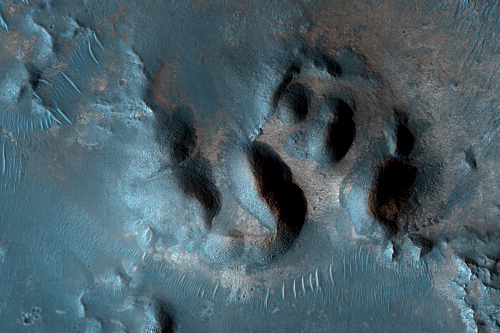PhysOrg | Space Exploration | 29 July 2010
Hydrothermal formation of Clay-Carbonate alteration assemblages in the Nili Fossae region of Mars -- AJ Brown et alA new article in press of the journal Earth and Planetary Science Letters unveils groundbreaking research on the hydrothermal formation of Clay-Carbonate rocks in the Nili Fossae region of Mars. The findings may provide a link to evidence of living organisms on Mars, roughly 4 billion years ago in the Noachian period.
The paper "Hydrothermal formation of Clay-Carbonate alteration assemblages in the Nili Fossae region of Mars", by Adrian J. Brown et al, suggests that carbonate bearing rocks found in the Nili Fossae region of Mars are made up of hydrothermally altered ultramafic (perhaps komatiitic) rocks.
It also shows that the carbonates at Nili Fossae are not pure Mg-carbonate. Moreover, the study explains that talc is present in close proximity to the carbonate locations - rather than previously suggested saponite - and talc-carbonate alteration of high-Mg precursor rocks has taken place.
Adrian Brown, corresponding author, explains: "We suggest that the associated hydrothermal activity would have provided sufficient energy for biological activity on early Mars at Nili Fossae. Furthermore, in the article we discuss the potential of the Archean volcanics of the East Pilbara region of Western Australia as an analog for the Nochian Nili Fossae on Mars. They indicate that biomarkers or evidence of living organisms, if produced at Nili, could have been preserved, as they have been in the North Pole Dome region of the Pilbara craton."
- Earth and Planetary Science Letters (in press) doi: 10.1016/j.epsl.2010.06.018
Space.com | 30 July 2010
Color Image of Nili Fossae Trough (PSP_003086_2015)A spot on Mars called Nili Fossae that is rich in clay mineral-rich rocks could be a prime spot to search for the fossilized remains of Martian life that may have existed 4 billion years ago, a new study suggests.
In the study, scientists used an instrument on NASA's Mars Reconnaissance Orbiter to study clay-carbonate rocks on the Martian surface leftover from ancient red planet era known as the Noachian period.
The study does not offer actual evidence of past life; rather, it suggests a place that might have been habitable.
"We suggest that the associated hydrothermal activity would have provided sufficient energy for biological activity on early Mars at Nili Fossae," said study lead author Adrian Brown, a scientist at the Search for Extraterrestrial Intelligence Institute (SETI) in Mountain View, Calif., in a statement.
The study's findings will be detailed in an upcoming issue of the journal Earth and Planetary Science Letters.
...
The Nili Fossae region was seen as an ideal area to investigate the potential habitability of early Mars. At one point, it was in the running as one of seven candidate landing sites for NASA's upcoming Mars Science Laboratory rover mission.
Since then, NASA scientists have whittled the candidate rover landing targets to four locations on Mars known as Mawrth Vallis, Gale crater, Holden crater and Eberswalde crater.
Brown and his team of researchers used the Compact Reconnaissance Imaging Spectrometer for Mars (CRISM) instrument onboard NASA's Mars Reconnaissance Orbiter. Crism studied the ancient rocks with infrared light.
The Nili Fossae region of Mars is one of the largest exposures of clay minerals discovered by the OMEGA spectrometer on Mars Express and mapped in greater detail by the CRISM spectrometer on MRO (see the gallery).
In the HiRISE IRB color, dark blue regions are basaltic in composition, including sand-sized material that bounces around in the wind to form dunes. Basalt in the most common type of volcanic rock on the Earth and other terrestrial planets.
The light-toned areas (with a variety of colors) and covered by small-scale fractures is the clay-rich material. Clay minerals contain hydrogen and oxygen (i.e., water) within their mineral structure, and may also preserve organic materials, so there is great interest in studying these deposits to understand past environments that could have supported life.
Credit: NASA/JPL/University of Arizona
